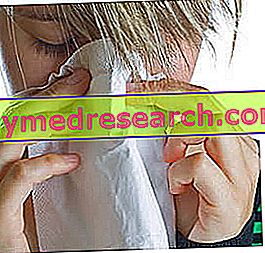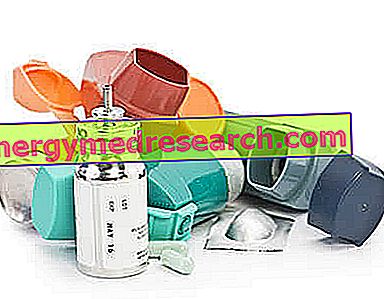What is atopy?
The term "atopy" comes from the Greek word ατοπία, whose literal meaning is " reaction that causes a bizarre and eccentric disease" . By atopy, in fact, we mean the subject's predisposition to manifest anaphylactic reactions determined by contact, ingestion or inhalation of a given antigen (allergen).
Atopy is a disease known since ancient times, so much so that Octavian Augustus was also affected (according to the testimony of Suetonius, reported in the work De Vita Caesarum ).
Causes and hypotheses

Although atopy represents a very ancient disease, it is still the object of study, since the mechanisms that govern it are quite complex: the genes involved in atopy are many and can vary not only from subject to subject (genetic heterogeneity), but also to diversify according to the ethnic group and the environment in which one finds oneself. In fact, different genes can provoke the same manifestations (phenotypic expression) in the various races; in this regard it is impossible to establish with certainty the gene responsible for atopy. As mentioned, even the environment can influence the atopic manifestation: a sensitive person could manifest the disease with different symptoms depending on the environment in which it is found at that given moment: this happens because the mutation of the gene is different according to the characterization environmental.
Why does it manifest itself?
In subjects suffering from atopy there was a marked tendency to develop IgE (type E immunoglobulins, antibodies produced by the body to defend it from the attack of potentially dangerous pathogens); IgE are produced following contact with antigen proteins and, in the case of excessive production, the body can respond with asthma, atopic dermatitis and rino-conjunctivitis.
Following contact with an antigen considered to be an allergen, there is an overproduction of IgE, consequently favoring the triggering of a chain reaction that causes the activation of T lymphocytes, the production of histamine and the creation of istamino-mediated processes. that determine atopy. The cells used for the production of histamine are the basophils and the mast cells, which bind to the IgE because on their surface they present the receptor for the activation of the process.
Symptoms
Atopy is considered an alarming disease, especially for young people who are most affected by it, because their skin and their immune system are more sensitive than those of adults. With the manifestations that derive from atopy the quality of life of the child is decidedly influenced and compromised, also affecting the family. It must be borne in mind, in fact, that atopy manifests itself with asthma, rhinitis, more or less widespread eczema, widespread itching, exudation and vesicles; to these disorders are then added other subjective psychological conditions, such as anxiety, insomnia, tendency to irritability, concentration difficulties etc.
The lesions dislocate above all on the face, in particular on the cheeks and forehead, provoking an alteration of the harmonic image of the subject; still, atopy manifests itself on the legs and arms, favoring the formation of lichenified areas (thick and keratinized).
The problem, seen from the eyes of a child, can be enormous and insurmountable, which is why atopy affects the quality of life of children. Even the lives of families that present at least one subject with atopy is compromised: precisely, if the sick person is a child, the usual family conditions must undergo some changes, because more attention must be paid to the child's activities, to what he eats, and what it touches: even the contact with clothes can set up atopy.
Care
The care for the sick is very expensive: the problem most felt, however, is not so much the cost of treatment, but the awareness that there is no definitive and certain remedy, capable of completely eradicating the disease. Treatments to combat atopy should be followed throughout life. However, it is certain that atopy is not a disease that manifests itself continuously: only if provoked by triggering factors will it explode in its manifestations.
If the diagnostic tests highlight the predisposing factors, the affected subject must avoid contact or ingestion of that given substance (allergen).
The possible therapies are represented by the use of topical corticosteroids, which dismantle the symptom but not the disease; even emollient, nourishing and moisturizing preparations are useful. In the most severe forms, the doctor recommends the use of immunosuppressive drugs; the administration of antihistamines per os is useful to eliminate itching. If atopy is caused by the attack of pathogenic bacteria, antibiotics are able to eradicate the microorganism.
In some cases, phototherapy is an alternative method of resolving allergic symptoms.
The progress of modern science and research has proved to be exceptional, so much so that the quality of life of people affected by atopy can be improved.
Summary on atopy
Disease | Atopy = predisposition of the subject to manifest anaphylactic reactions determined by contact, ingestion or inhalation of a given antigen. |
Origin of the name | Atopia derives from the Greek word ατοπία, whose meaning is a reaction that causes a bizarre and eccentric disease . |
Related pathology | Asthma, rhinitis, more or less widespread eczema, widespread itching, exudation, atopic dermatitis and rino-conjunctivitis vesicles. |
Related problems | Anxiety, insomnia, tendency to irritability, difficulty concentrating, etc. |
Trigger | Alteration of the subject's immune system: super IgE production, antibody activation, T lymphocyte activation, histamine production and atopic manifestation outbreak. |
Incidence | Atopy afflicts 10-15% of the world population: from medical statistics it seems that almost two million children and adolescents are affected. |
Areas affected | Face - in particular cheeks and forehead - legs and arms, with formation of lichenified areas. |
Prevention | Extension from contact / ingestion / inhalation of the substance that triggers atopy. |
Remedies |
|



